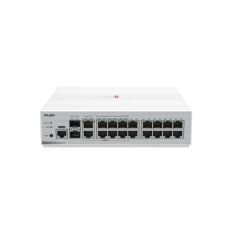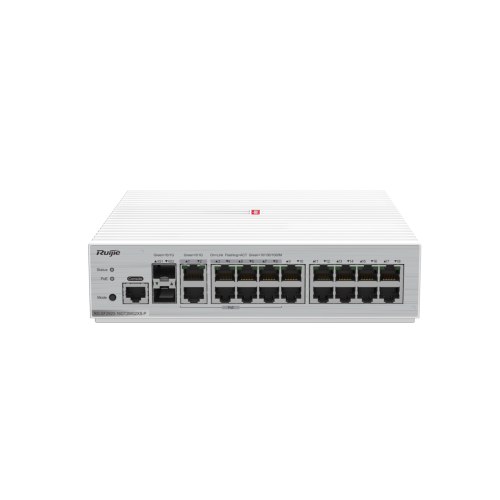RG-SF2920-16GT2MG2XS-P 16-Port GE All-Optical PoE Switch, 2 × 5G Electrical Ports (Backward Compatible) Best Price In Dubai, UAE.
Availability:
In Stock
Various port combinations, rate increase, installation in a concealed telecommunication box, recommended for indoor use, aesthetically pleasing design, and security
Highlight Features
- Various port combinations, surge protection greater than 8 kV, PoE+, 16 × 10/100/1000Mbps copper ports with auto-negotiation, 2 × Gigabit/5G copper ports, and 2 × 10G uplink fiber ports
- Small size, flexible and fast installation, efficient heat dissipation, and low noise
- New 5G Ethernet port, meeting the requirements of new services and enhancing service scalability
- Reliability enhancement, metal enclosure, metal Ethernet ports, independent optical transceiver design, and more stable data forwarding
- Easy and effective network-wide management, ensuring high security and reliability for networks
Description
Key Specification
All-Optical Ethernet Switch RG-SF2920-16GT2MG2XS-P
The Ethernet architecture and novel Fiber-to-the-Room (FTTR) deployment delivers 10G fiber-to-the-room access. This switch provides 16 × 1G Ethernet ports with auto-negotiation, 2 × 2.5G optical ports, 2 × 10G uplink optical ports, rich interfaces, and is PoE+ compatible, supporting full service expansion

Small Size, Space Saving, Aesthetically Pleasing Design, and No Security Concern
This compact switch comes with various mounting brackets to suit different environments. It can be flexible installed in a concealed ELV box, in a customized cabinet or under a workbench.

Specifications
Hardware Specifications
| Hardware Specifications |
RG-SF2920-16GT2MG2XS-P |
||
| Interface Specifications |
|||
| Fixed port |
16 x 10/100/1000M auto-negotiation electrical ports 2 x 1000M/2.5G/5G adaptive electrical ports 2 x 1G/10G SFP+ ports, Electrical ports 1-8 support PoE/PoE+ |
||
| Power module |
Fixed single AC power supply |
||
| Fan module |
Fanless |
||
| Fixed management port |
1 x console port |
||
| System Specifications |
|||
| Packet forwarding rate |
68.44 Mpps |
||
| Switching capacity |
92 Gbps |
||
| Number of MAC addresses |
Number of global MAC addresses: 16,000 Number of static MAC addresses: 1,000 |
||
| ARP table size |
1,000 |
||
| Number of IPv4 unicast routes |
500 |
||
| Number of IPv6 unicast routes |
500 |
||
| Number of ACEs |
Ingress: 1,500 Egress: 500 |
||
| Dimensions and Weight |
|||
| Dimensions (W x D x H) |
210 mm x 235 mm x 55 mm (8.27 in. x 9.25 in. x 2.17 in.) |
||
| Weight (full configuration, including packaging) |
3.12 kg (6.88 lbs) |
||
| CPU and Storage |
|||
| CPU |
MAC chip with built-in single-core CPU, 1 GHz |
||
| Storage |
512 MB SDRAM 256 MB flash memory |
||
| Data packet buffer |
12 MB |
||
| Power and Consumption |
|||
| Maximum power consumption |
< 25 W (without PoE full load) < 150 W (with PoE full load) |
||
| Rated input voltage |
AC input: 200 V AC to 240 V AC @ 50 Hz to 60 Hz |
||
| Maximum input voltage |
AC input: 180 V AC to 264 V AC |
||
| Environment and Reliability |
|||
| MTBF |
40°C (104°F): > 300K |
||
| Primary Airflow |
Natural heat dissipation |
||
| Operating temperature |
0°C to 50°C (32°F to 122°F) |
||
| Storage temperature |
–40°C to +70°C (–40°F to +158°F) |
||
| Operating humidity |
5% to 95% RH (non-condensing) |
||
| Storage humidity |
5% to 95% RH (non-condensing) |
||
| Interface surge protection |
Power port: 6 kV (common/differential mode) Communication port: 8 kV (common mode) |
||
| Operating altitude |
0 m to 5000 m (16404.20 ft.) |
||
Software Specifications
| RG-SF2920-16GT2MG2XS-P |
|
| Feature |
Description |
| Ethernet switching |
Jumbo frame length: 9,216 bytes |
| IEEE 802.3az EEE |
|
| Maximum number of VLANs that can be created: 4,094 |
|
| Voice VLAN |
|
| Private VLAN |
|
| MAC VLAN MAC address-based, port-based, protocol-based, and IP subnet-based VLAN assignment |
|
| GVRP |
|
| Basic QinQ and flexible QinQ |
|
| STP (IEEE 802.1.d), RSTP (IEEE 802.1w), and MSTP (IEEE 802.1s) |
|
| ERPS (G.8032) with switching time ≤ 50 ms |
|
| LLDP/LLDP-MED |
|
| IP service |
DHCP server, DHCP client, DHCP snooping, and DHCP snooping |
| DNS |
|
| DHCPv6 client, DHCPv6 relay, and DHCPv6 snooping |
|
| Neighbor Discovery (ND) |
|
| IP routing |
Static routing |
| Static blackhole routing |
|
| RIP v1/v2 and RIPng |
|
| OSPFv2 and OSPFv3 |
|
| GR |
|
| Multicast |
IGMPv1/v2/v3 snooping |
| IGMP fast leave |
|
| ACL and QoS |
Standard IP ACLs (IP-based hardware ACLs) |
| Extended IP ACLs |
|
| Extended MAC ACLs |
|
| Expert-level ACLs |
|
| ACL80 and IPv6 ACLs |
|
| ACLs on Layer 2 and Layer 3 interfaces |
|
| Applying ACLs globally (hardware ACLs based on flexible combinations of the VLAN ID, Ethernet type, MAC address, IP address, TCP/UDP port number, protocol type, and time range) |
|
| ACL redirection |
|
| Traffic classification based on 802.1p priorities, DSCP priorities, and IP precedences |
|
| Congestion management: SP, WRR, DRR, WFQ, SP+WRR, SP+DRR, SP+WFR, and SP+WFQ |
|
| Congestion avoidance: tail drop |
|
| Rate limiting based on the inbound or outbound interface |
|
| Eight queues on each port |
|
| Rate limiting in each queue |
|
| Security |
RADIUS and TACACS+ |
| RADIUS authentication and authorization |
|
| TACACS+ |
|
| IEEE 802.1X authentication, MAC address bypass (MAB) authentication, and interface-based and MAC address-based 802.1X authentication |
|
| Web authentication |
|
| Hypertext Transfer Protocol Secure (HTTPS) |
|
| SSHv1.5 and SSHv2.0 |
|
| Global IP-MAC binding |
|
| ICMP (discarding ICMP packets of which the rate exceeds the threshold on an interface) |
|
| Port security |
|
| BPDU guard |
|
| Filtering of invalid MAC addresses |
|
| Broadcast storm suppression |
|
| Hierarchical management of administrators and password protection |
|
| IP source guard |
|
| ARP spoofing prevention |
|
| CPP and NFPP |
|
| DAI Portal authentication Login authentication and password security Unknown unicast suppression |
|
| Various attack defense functions including NFPP, ARP anti-spoofing, DHCP/DHCPv6 attack defense, ICMP attack defense, ND attack defense, IP scanning attack defense, and customizing attack defense packet types |
|
| Reliability |
REUP |
| Rapid Link Detection Protocol (RLDP), Layer 2 link connectivity detection, unidirectional link detection, and VLAN-based loop control |
|
| Load balancing LACP dynamic aggregation The LACP priority, negotiation mode, and maximum number of ports that can be aggregated can be configured. Cross-VSU aggregate interface |
|
| DLDP |
|
| IPv4 VRRP v2/v3, IPv6 VRRPv3 |
|
| GR for OSPF |
|
| NMS and Maintenance |
RSPAN and ERSPAN |
| Flow- and VLAN-based SPAN |
|
| sFlow (network detection technology based on packet sampling, which is mainly used for traffic statistics and analysis in heavy-traffic scenarios) |
|
| NTP and SNTP |
|
| 1:1 mirroring, N:1 mirroring, and 1:N mirroring Cross-device traffic mirroring SPAN, RSPAN, and ERSPAN |
|
| FTP and TFTP |
|
| SNMP v1/v2c/v3 |
|
| RMON (1, 2, 3, 9) |
|
| CLI (Telnet/console), Syslog/debugging, and web |
|
| Various types of RMON groups, including event groups, alarm groups, history groups, and statistics groups, as well as private alarm extension groups RMON used to implement Ethernet statistics, historical statistics, and alarm functions |
|
| CWMP |
|
| OpenFlow Special 1.0/1.3 |
|
| Periodic and automatic restoration of the port in errdisable state |
|
| Flow table analysis defined by all protocols Transmission of specified packets to the controller Configuring the controller's IP address and port Notifying port status changes to the controller |
|
| PoE |
RG-SF2920-16GT2SFP-P, RG-SF2920-8GT2MG2XS-P, and RG-SF2920-16GT2MG2XS-P: ● Electrical ports in compliance with IEEE 802.3af (15.4 W) and IEEE 802.3at (30 W) ● Automatic and energy-efficient power supply management modes ● Warm start to implement uninterrupted power supply ● Port priority |






Reviews (0)